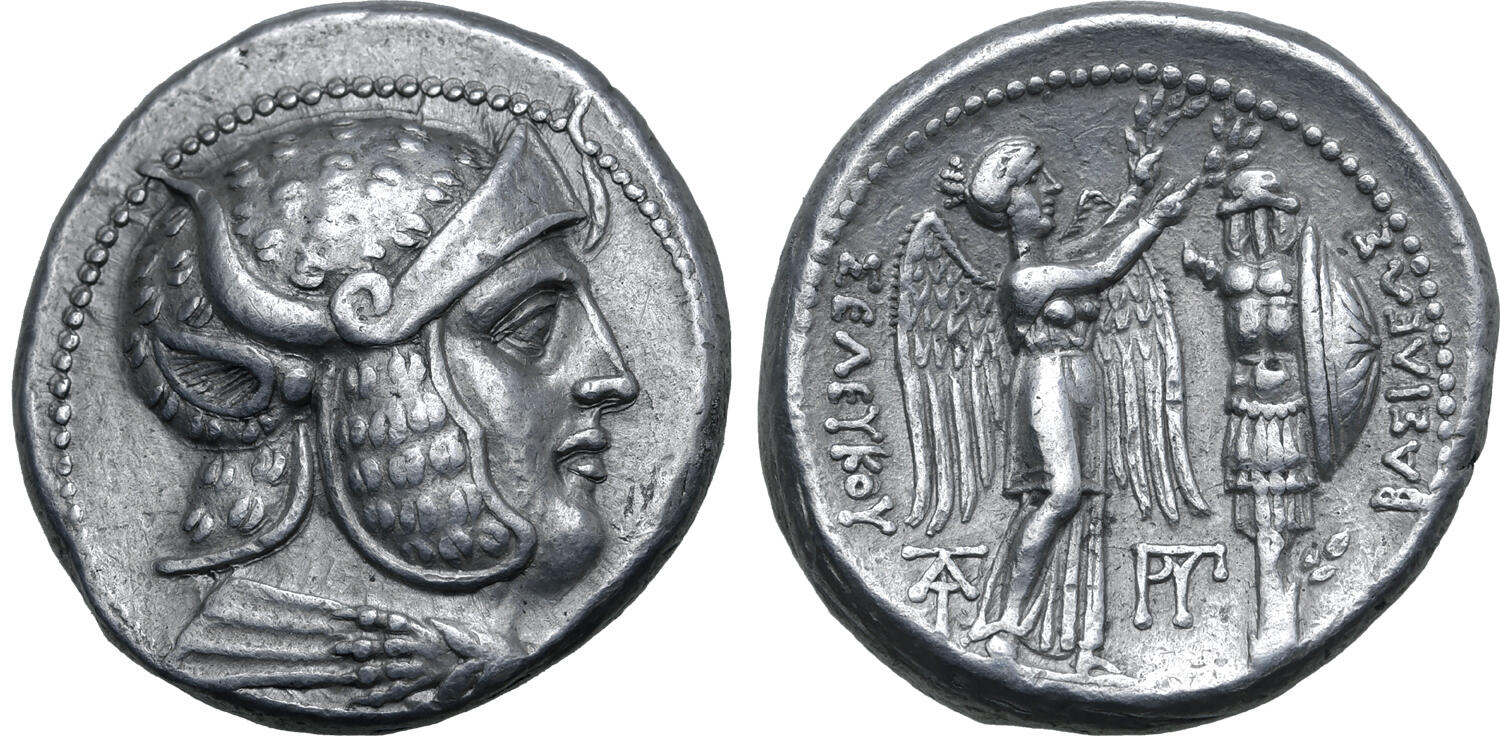S 402 - Susa (Seleucus I), silver, tetradrachms (301-295 BCE) Marest-Caffey
From SILVER
301 BCE - 295 BCE Silver 9,143 kg
Description
| ObverseInscription or printing placed on the obverse.: | Head of Seleucus I Nikator right, wearing a helmet covered by a panther skin, with ears and horns of a bull, a panther skin around the neck. Border of dots. |
| ReverseInscription or printing placed on the reverse.: | BAΣΙΛΕΩΣ ΣΕΛΕΥΚΟΥ (Greek).Nike right crowning a trophee. (Between them, 2 letters, Boeotian shield or monogram.) In the field, 1/2 letter(s) and/or a monogram and/or a symbol (Boeotian shield or Helios head). Border of dots. |
Mint and issuing power
| MintIdentifies the place of manufacture or issue of a numismatic object.: | Susa | Ancient regionAncient region.: | Mesopotamia | Modern countryModern country: Iran | AuthorityIdentifies the issuing power. The authority can be "pretended" when the name or the portrait of X is on the coin but he/she was not the issuing power. It can also be "uncertain" when there is no mention of X on the coin but he/she was the issuing power according to the historical sources: | Seleucid Dynasty (312-63 BC), Seleucus I Nicator (satrap in 321-305 BC and Seleucid king in 305-281 BC) |
Chronology
| FromIdentifies the initial date in a range assigned in a numismatic context. | 301 BCE | toIdentifies the final date in a range assigned in a numismatic context.. | 295 BCE | PeriodTime period of the numismatic object.: Hellenistic 323-30 BC |
Physical description
| MetalThe physical material (usually metal) from which an object is made.: | Silver |
Median weightMedian of the weights of numismatic objects (in grams). in grams | 16.90 | DenominationTerm indicating the value of a numismatic object. Examples: tetradrachm, chalkous, denarius.: | tetradrachm |
StandardStandard.: | Attic |
Image

S402 Susa Seleucus I tetradrachms trophy.jpg [1]
References
| Die study referencePublication of the study: | Marest-Caffey 20161Marest-Caffey 2016, p. 29-41, n° 1-191 and p. 57-58, n° Ad1-Ad15 (Group 1) | ||
| Coin series referenceReference to coin series study: | Sear II2Sear II, n° 6833, SC I3SC I, n° 173, HGC 94HGC 9, n° 20 | ||
Obverse dies distribution
| FrequencyFrequency of specimen in distribution. ᵖ | Number of obversesNumber of obverse dies. ᵖ (o) | % (o) | Number of coinsNumber of coins. (n) | % (n) | Die nameName(s) of the die(s). |
| 1 | 5 | 19.23 | 5 | 2.46 | 2, 9, 12, 13, 20 |
| 2 | 3 | 11.54 | 6 | 2.96 | 14, 24, 26 |
| 3 | 1 | 3.85 | 3 | 1.48 | 10 |
| 4 | 1 | 3.85 | 4 | 1.97 | 11 |
| 5 | 2 | 7.69 | 10 | 4.93 | 3, 15 |
| 6 | 2 | 7.69 | 12 | 5.91 | 7, 8 |
| 7 | 1 | 3.85 | 7 | 3.45 | 6 |
| 9 | 2 | 7.69 | 18 | 8.87 | 1, 4 |
| 10 | 1 | 3.85 | 10 | 4.93 | 22 |
| 12 | 2 | 7.69 | 24 | 11.82 | 5, 25 |
| 13 | 2 | 7.69 | 26 | 12.81 | 16, 18 |
| 14 | 1 | 3.85 | 14 | 6.9 | 19 |
| 19 | 1 | 3.85 | 19 | 9.36 | 21 |
| 22 | 1 | 3.85 | 22 | 10.84 | 23 |
| 23 | 1 | 3.85 | 23 | 11.33 | 17 |
| Total | 26 of 26 | 100.02 | 203 of 203 | 100.02 |
Reverse dies distribution
no distribution is available
Quantification
| Number of obversesNumber of obverse dies. ᵖ (o) | 26 | Number of singletons (o1)The number of singleton coins. ᵖ | 5 |
| Number of reverse diesNumber of reverse dies. (r) | 85 | Number of coinsNumber of coins. (n) | 203 |
| Coins per obverse dieNumber of coins per obverse die. (n/o) | 7.81 | Coins per reverse dieNumber of coins per reverse die. (n/r) | 2.39 |
| Reverse per obverse ratioRatio of obverse dies divided by reverse dies. (r/o) | 3.27 | Percentage of singletons (o1)number of coins (n) divided by the number of singletons (o1) ᵖ | 19.23 % |
| Original number of dies (O) (Carter 1983 formula)The estimation of the number of coins according to Carter 1983 ᵖ | 27.05 | Coins struck if 20,000 as average productivity per dieCoins made if the average productivity for obverses (according to Carter) is 20,000. ᵖ | 541,000 |
| Original number of dies (O) (Esty 2011 formula)The estimation of the number of coins according to the singleton formula in Esty 2011 ᵖ (O) | 29.82 | Survival rate if 20,000 as average productivity per dieSurvival rate if average productivity is 20,000. ᵖ | 0.00038 |
| Coverage (o = % of O) (Esty 1984 formula)Esty 1984 - coverage (% of O) ᵖ (o = % of O) | 97.54% | Die productivity if survival rate 1/2,000Average productivity if survival rate is 1/2,000. ᵖ | 15,009.24 |
| Weight of silver (in kg) if 20,000 coins per die (O = Carter formula)Carter 1983 * Median weight * 20000 (*10 if gold or electrum) ᵖ | 9,143 kg <br /> 9,143 kg | Die productivity if survival rate 1/5,000Average productivity if survival rate is 1/5,000. ᵖ | 37,523.11 |
Remarks